
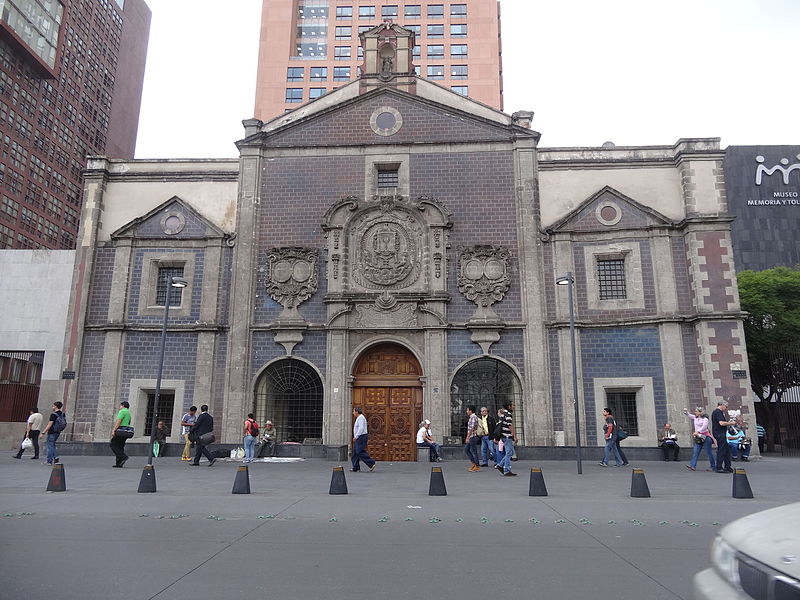
The former Corpus Christi Temple is one of the most inquired about buildings facing the Alameda Central. It was originally a Catholic temple annexed to a convent of the same name. That space is currently occupied by Mexico’s Secretariat of Foreign Affairs complex. The complex includes the Museum of Memory and Tolerance. Both the Convent and the Temple were run under the auspices of the Order of the Capuchin Poor Claires. It was, importantly, the first monastery exclusively for indigenous women. Today it houses the historical archives of Mexico City land notaries.

Both the temple and the convent were built between 1720 to 1724 by the acclaimed architect, Pedro de Arrieta. He abandoned the standard of the two entryways then typical of convent churches. There is thought to be influence here of the work he’d done on the Chapel of the Souls between 1720 and 1721. (That work is immediately behind the Metropolitan Cathedral)
The convent was exclusively for the daughters of noble indigenous peoples. It was vacated in 1867, after the Second Empire, and with the application of the Reform Laws. José Ives Limantour, the Secretary of Finance under Porfirio Díaz from 1895, purchased the property. He ordered the convent demolished and only the temple and a small cloister remained.
After the exclaustration, the temple was used as a winery, a schismatic temple, and a hygiene museum. In 1951, it was handed over to the newly created National Indigenous Institute to found the museum of industries and popular arts. It was thus used until the 1980s. Severely damaged by the 1985 earthquake, it was abandoned for almost 20 years. In 2002, as part of the rescue plan for the Historic Center, the former temple would be consolidated and restored to be the headquarters of the historical collection of the general archive of notaries of Mexico City. Work began in 2003 and the collection was opened in 2005.
Although it can’t today be visited by the public, the Corpus Christi Temple faces the Alameda Central. It’s thus within easy walking distance to both the many sites of the Alameda Central Area, and the San Juan Moyotlan neighborhood to the immediate south.
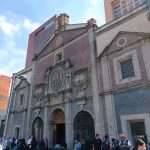 In 1720, the Viceroy Marquis of Valero hired the famed architect Pedro de Arrieta to build a temple and convent dedicated to women of indigenous origin. This fact was remarkable, since indigenous peoplewere considered "new Christians" and therefore were excluded from priestly orders and monastic life. Two centuries after the beginning of the Christian evangelization in New Spain, the daughters of indigenous caciques were able to enter the convent of the Poor Clares of Corpus Christi. These foundation gave rise to the convents of Oaxaca and Morelia.
In 1900, the old temple was redecorated by Emilio Dondé, in 1920 the vestiges of the convent were demolished, leaving the church exempt. In 1942 a Hygiene Museum was inaugurated there. In 1971, this became the Museum of Popular Arts and ia mural was executed in the high choir of the old temple. The work of Miguel Covarrubias, it represents a map of Mexican handicrafts.
It is currently the headquarters of the Historic Archive of Notaries of Mexico City within a complex of administrative buildings built between 2001 and 2004.
In 1720, the Viceroy Marquis of Valero hired the famed architect Pedro de Arrieta to build a temple and convent dedicated to women of indigenous origin. This fact was remarkable, since indigenous peoplewere considered "new Christians" and therefore were excluded from priestly orders and monastic life. Two centuries after the beginning of the Christian evangelization in New Spain, the daughters of indigenous caciques were able to enter the convent of the Poor Clares of Corpus Christi. These foundation gave rise to the convents of Oaxaca and Morelia.
In 1900, the old temple was redecorated by Emilio Dondé, in 1920 the vestiges of the convent were demolished, leaving the church exempt. In 1942 a Hygiene Museum was inaugurated there. In 1971, this became the Museum of Popular Arts and ia mural was executed in the high choir of the old temple. The work of Miguel Covarrubias, it represents a map of Mexican handicrafts.
It is currently the headquarters of the Historic Archive of Notaries of Mexico City within a complex of administrative buildings built between 2001 and 2004.
Heart of México Walking Route: Alameda - Madero
< < Juárez Hemicycle | Palacio de Bellas Artes > >
Proyecto “Corredor de Cultura Digital”.
Nombre de la investigación: Investigación Centro Histórico, Monumentos, Edificios y Puntos de Interés (2023)
Dirección de investigación y diseño de Rutas: Acércate al Centro A.C. Guadalupe Gómez Collada
Coordinación e investigación histórica: Fideicomiso del Centro histórico Dir. Maestra Loredana Montes
 55 5518 1475
55 5518 1475
 http://data.consejeria.cdmx.gob.mx/index.php/dgjel/archivo-general-notaria
http://data.consejeria.cdmx.gob.mx/index.php/dgjel/archivo-general-notaria
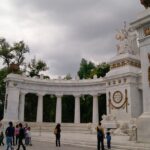
Nearest at 0.04 kms.
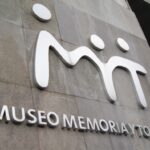
Nearest at 0.07 kms.
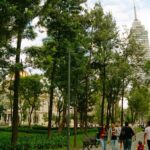
Nearest at 0.11 kms.
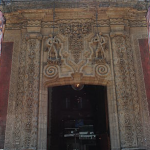
Among the strongest places to see historical and colonial period art works . . .
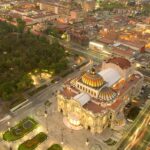
Bellas Artes has long been an iconic symbol of Mexico City's culture and performing arts.
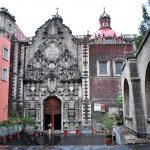
One of the oldest places on today's calle Madero, the temple is only accessible through a remaining side chapel.
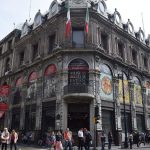
One of the most eclectic of museums, at home in one of the most dynamic of late 19th century buildings.

The Benito Juarez monument is just one of the most prominent points of interest in the Alameda Central.